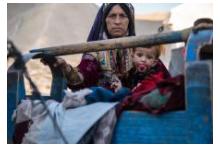Over three decades of conflict in Afghanistan, combined with an economic collapse and climate
shocks, have created a severe humanitarian crisis. Ordinary families are paying the highest price, with more than 23 million people left in urgent need of aid. Tragically, funding cuts and restrictions imposed by the Taliban have made it difficult to reach those in need.
The International Rescue Committee (IRC) is on the ground in Afghanistan, delivering critical services to people in crisis. Here’s what Afghan families are up against—and how your support can help us make a difference, even in the most challenging conditions:
Since 2022, women and girls over the age of 12 have been banned from attending schools or universities. In response, the IRC launched community-based education programs in six Afghan provinces, reaching tens of thousands of children, especially girls, who would otherwise be unable to access education.
More than 14 million people across Afghanistan have limited or no access to health care. The IRC supports local clinics and deploys mobile health teams to reach remote communities with essential care, including maternal and reproductive health services, so families can stay healthy even in the most hard-to-reach areas.
Malnutrition is an urgent challenge in Afghanistan. In 2024, more than 14 million people faced crisis, or worse, levels of food insecurity, with little sign of improvement. As drought and rising food prices push more families toward hunger, IRC teams are delivering malnutrition programming across 10 provinces. Our cost-effective approach to treatment helps more than 90% of treated children recover—making your donation go further.
The IRC started in Afghanistan in 1988. Today, we deliver services across eleven provinces to help people in crisis survive, recover, and rebuild their lives. In addition to education, health care and nutrition support, the IRC helps communities manage their own recovery through cash assistance, clean water and sanitation programs, emergency supplies, and job training that builds long-term resilience. In 2024 alone, we reached more than 2.2 million people in Afghanistan with lifesaving aid.
As humanitarian needs grow and global funding declines, Afghan families are being left behind. Your support can help deliver the aid they urgently need. Donate today to provide lifesaving assistance to families in Afghanistan and other crisis-affected communities around the world.
$6 can provide one warm blanket
$25 can provide one month of emergency food packets for one child
$48 can cover the cost of school fees and supplies for a child
$150 can provide one family with livestock
$240 can provide one classroom with chairs, tables, and chalkboards
$500 can help equip an emergency mobile medical team
